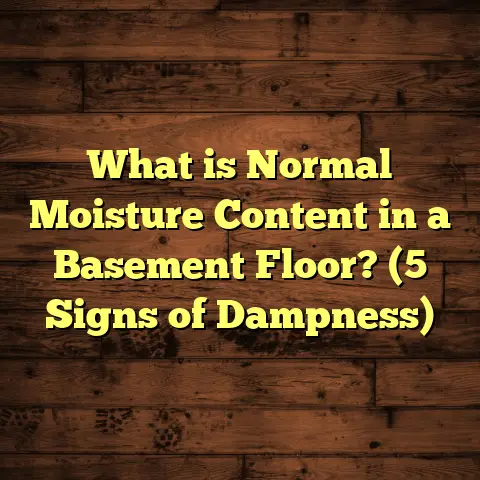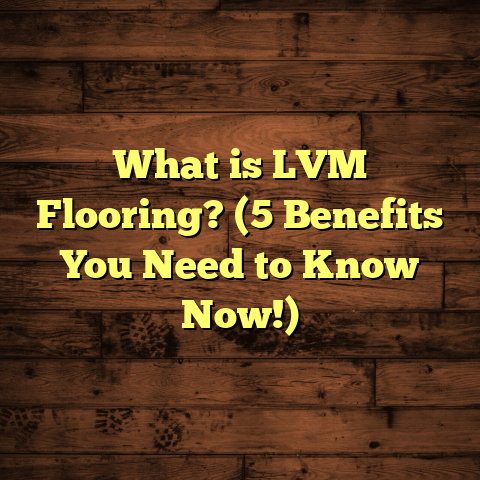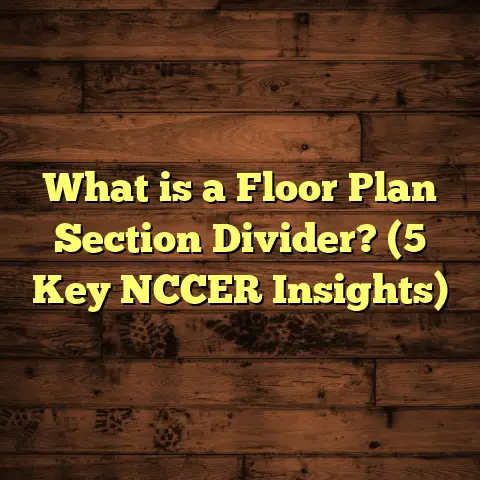What is Bamboo Hardwood Floor? (5 Benefits You Must Know!)
I still remember that feeling the first time I stepped onto a bamboo hardwood floor. There was something grounding about it—something alive yet sophisticated—that just grabbed me. I’ve been working with floors for years, laying down everything from classic oaks to sleek laminates, but bamboo floors brought a fresh perspective. They felt like a bridge between nature and modern living, strong yet elegant, eco-friendly yet durable. Since then, bamboo hardwood flooring has become a favorite option I recommend to many clients, but it’s not without its quirks.
If you’ve ever wondered what bamboo hardwood floors really are or whether they’d work for your home or project, I want to share everything I’ve learned—from the basics to the benefits, the bumps in the road, and even some insider tips I picked up along the way. Let’s talk about bamboo flooring like friends chatting over coffee.
What Is Bamboo Hardwood Floor?
At its core, bamboo hardwood flooring is made from bamboo grass rather than traditional trees, which is what makes it stand out in a crowded flooring market. Unlike oak, maple, or walnut hardwoods that take decades to mature, bamboo grows incredibly fast—some species can grow up to 3 feet in just 24 hours! This rapid growth cycle means it can be harvested every 3 to 5 years, making it one of the most renewable natural resources available for flooring.
But don’t let the “grass” label fool you. Bamboo floors are often categorized as hardwood floors because their density and hardness can rival or even surpass many traditional hardwood species. The term “hardwood” in flooring usually refers to the material’s durability and surface hardness rather than botanical classification.
Types of Bamboo Hardwood Flooring
There are three primary types of bamboo floors, each with distinct characteristics:
- Horizontal Bamboo: These planks showcase the natural grain horizontally across the width of each plank. You’ll see visible knots and natural bamboo “nodes,” giving it a rustic, organic look. It’s like seeing bamboo stalks laid flat.
- Vertical Bamboo: Here, bamboo strips are stacked vertically and glued side by side, creating a more uniform linear grain pattern that’s subtle and sleek.
- Strand-Woven Bamboo: This one gets my recommendation for durability. It’s made by shredding bamboo fibers and compressing them under high heat and pressure into dense blocks. The resulting floor is about twice as hard as red oak on the Janka hardness scale (which measures how much force a wood can withstand before denting).
This variety means you can find a style that fits anything from modern minimalism to cozy cabin vibes.
How Bamboo Flooring Is Made
The manufacturing process is quite involved but fascinating. After harvesting, the bamboo stalks are cut into strips and boiled in a solution to remove sugars and starches. This step is crucial because any sugar left behind attracts pests and mold. After drying, the strips are either laminated horizontally or vertically or shredded for strand-woven production.
The planks are then glued together with adhesives (some use formaldehyde-free options for healthier indoor air), pressed into shape, sanded smooth, and finished with tough protective coatings like aluminum oxide.
Why Bamboo Is Called Hardwood
You might wonder why we call bamboo a hardwood when it’s technically a grass. The distinction mostly comes down to hardness and durability rather than scientific classification. On the Janka scale, strand-woven bamboo scores around 3000 lbf (pounds-force), whereas red oak—one of the most common hardwoods—scores about 1290 lbf. That means strand-woven bamboo can be more than twice as hard as red oak!
Because of this strength, bamboo is often used in places where heavy foot traffic or pets are common, making it a practical alternative to traditional hardwood.
My Personal Experience With Bamboo Floors: Ups and Downs
I’ve installed dozens of bamboo floors over the years—from small apartments to large family homes—and while I’m generally impressed with its performance, there have been moments that taught me valuable lessons.
Wins Along the Way
- Eco-Friendly Choice: Many clients appreciate knowing they’re choosing a floor that grows quickly and regrows naturally without deforestation stress. This gives a sense of contributing to sustainability.
- Long-Term Durability: Strand-woven bamboo floors have held up beautifully even in homes with kids running around or dogs jumping everywhere. One home I worked on had two large dogs and after two years of rough use the floor still looked great with just minor surface wear.
- Aesthetic Versatility: Whether I needed a light natural finish for Scandinavian-style interiors or a dark espresso stain for more traditional looks, bamboo offered options that blended well with various decors.
- Moisture Resistance: In some coastal projects around Florida and Louisiana, I saw fewer issues with buckling or warping compared to traditional hardwoods that struggled under humidity.
- Affordable Compared to Exotic Woods: When clients wanted durable floors but were budget-conscious, bamboo was often their best bet. It saved them 30-40% compared to exotic hardwoods like Brazilian cherry or teak while still offering strength and beauty.
Challenges Faced
- Quality Control Variations: Not all bamboo floors are created equal. Early in my career, I ordered some inexpensive imports that warped within months or showed signs of poor adhesive bonding. This experience pushed me to source certified brands with stringent quality checks.
- Installation Sensitivity: Proper acclimation is critical with bamboo. I once installed floors too quickly in a newly built home that wasn’t climate-controlled properly; the planks expanded after installation causing gaps and buckling. Now I always recommend at least 72 hours of acclimation in the actual installation environment.
- Surface Vulnerability: Although strand-woven bamboo is tough, horizontal and vertical types can be scratched or dented more easily by sharp objects or heavy furniture legs unless protected well.
- Refinishing Limits: Bamboo generally can only be sanded and refinished 2-3 times because of its thin wear layer. That’s less than traditional hardwoods that can last for decades with multiple refinishes.
- Carbon Footprint Concerns: While bamboo itself is sustainable, most products come from Asia—primarily China—which means shipping adds carbon emissions that partially offset environmental benefits.
These ups and downs helped me become more knowledgeable about product selection and client education around maintenance needs.
Five Benefits You Must Know About Bamboo Hardwood Flooring
Let me share five reasons why I often recommend bamboo floors—and why you might want to consider them too if you’re thinking about upgrading your home’s flooring.
1. Rapid Growth Means Eco-Friendliness
Bamboo’s ability to mature in just 3-5 years compared to decades for most hardwoods makes it one of the planet’s most renewable resources. This quick replenishment means less pressure on forests and helps reduce deforestation rates globally.
To give you an idea:
- Traditional hardwood trees like oak take between 20 to 80 years to mature.
- Bamboo can be harvested every 3-5 years.
According to research from the University of California Agriculture & Natural Resources department:
Using bamboo flooring reduces carbon emissions by up to 25% compared to some hardwood floors due to faster growth cycles and less land degradation.
If you care about reducing your environmental footprint (and who doesn’t?), bamboo is a smart choice.
2. Superior Hardness and Durability
Bamboo’s strength is surprising for many people new to the material. Strand-woven bamboo scores around 3000 lbf on the Janka hardness scale—almost twice as hard as red oak (1290 lbf) and harder than hickory (1820 lbf). This means it resists dents from dropped objects or pet claws far better than many hardwoods.
Here’s something I saw firsthand: A family with two boisterous dogs had strand-woven bamboo installed in their entryway and living room. After two years of constant activity—dogs running inside/outside, kids playing—the floor showed hardly any dents or scratches.
That kind of durability does come with careful selection though; horizontal or vertical bamboo planks tend to be softer and more prone to surface damage.
3. Distinctive Appearance With Multiple Styles
Bamboo isn’t just another wood lookalike; it offers unique textures depending on how it’s made:
- Horizontal bamboo has wide grain rings resembling logs laid sideways.
- Vertical bamboo features thin stripes that create a clean linear effect.
- Strand-woven has a mottled appearance like granite or terrazzo with dense fiber patterns.
This range allows homeowners and designers to choose styles that suit anything from contemporary lofts to cozy cabins without sacrificing warmth or natural appeal.
4. Better Moisture Resistance Than Many Hardwoods
One common problem with traditional hardwood floors is their sensitivity to moisture changes causing cupping, warping, or gaps. Bamboo naturally fares better because of its denser fiber structure and treatments during manufacturing.
While it’s not waterproof (no wood floor ever is), I noticed fewer moisture-related problems during installations in high-humidity regions like Florida compared to oak or maple floors which tended to cup after storms or during rainy seasons.
5. Wallet-Friendly Without Sacrificing Quality
If you’ve priced exotic or premium hardwoods before, you know how quickly costs add up. Bamboo flooring typically costs between $3-$8 per square foot for materials depending on quality and style, whereas exotic woods can run $8-$15+ per square foot.
When paired with similar installation costs ($2-$6 per square foot), bamboo offers a strong balance between price and performance without making compromises on style or durability.
Installation Tips From My Toolbox
If you decide to go for bamboo floors (and I think you should consider it), here are some practical pointers I’ve gathered over years of installing them:
Acclimate Properly
Don’t rush installation after delivery! Let your planks sit in the exact room where they’ll be installed for at least 72 hours at typical indoor humidity and temperature levels. This helps them adjust and prevents expansion or contraction issues later.
Use Quality Vapor Barriers
If installing over concrete slabs or basements prone to moisture seepage, adding a vapor barrier beneath the flooring is essential to prevent damage from water vapor rising up through the slab.
Pick Strand-Woven For Heavy Use Areas
If you expect lots of foot traffic or pets running around, strand-woven bamboo is worth investing in due to superior hardness.
Clean Gently But Regularly
Bamboo floors look best when kept clean but avoid harsh chemicals or abrasive scrubbers that can wear down finishes prematurely. Use microfiber mops and gentle wood floor cleaners instead.
Add Furniture Pads
Even tough floors can scratch under heavy furniture if moved frequently. Felt pads under chair legs and tables help protect surfaces over time.
Don’t Ignore Refinishing Needs
When scratches appear or the finish dulls after several years, refinishing can restore beauty but expect fewer total refinishes than traditional hardwoods since wear layers are thinner on most bamboo products.
How FloorTally Became My Secret Weapon For Costing Flooring Jobs
Estimating flooring costs accurately used to be one of my biggest headaches early on—juggling bids from suppliers, varying labor rates, plus factoring waste percentages often led to surprises mid-project that clients didn’t love hearing about.
Then I started using FloorTally—a tool that lets me input local material prices, labor costs, waste factors (usually around 5-10%), and finishes all in one place for quick but detailed estimates tailored specifically for each project type including bamboo flooring options.
I find it especially helpful because:
- It consolidates everything into one platform so I don’t need multiple quotes.
- It allows customization for different material grades/styles.
- Gives clear breakdowns so I can explain exactly where money goes.
- Helps compare costs between materials like hardwood vs bamboo transparently.
Using this tool saved me tons of time and built trust with clients since budgets stayed more accurate without surprises down the line—something every contractor aims for but isn’t always easy to deliver!
What Industry Data Says About Bamboo Flooring
Beyond my personal experience, here’s what data from reports and consumer feedback say:
- The global bamboo flooring market size was valued at over $3 billion in 2022 and is expected to grow at approximately 6% compound annual growth rate (CAGR) through 2030 due to increasing demand for sustainable building materials (Source: Grand View Research).
- Consumer satisfaction surveys show over 80% positive reviews for strand-woven bamboo flooring specifically citing durability and aesthetics as top reasons (Source: Houzz).
- Environmental studies highlight lower indoor volatile organic compound (VOC) emissions from high-quality bamboo products compared with some engineered hardwoods treated with formaldehyde-based adhesives (Source: EPA).
This data aligns well with what I see on job sites where high-quality bamboo performs consistently well both practically and environmentally.
Real-Life Stories From My Floors
Sometimes numbers don’t tell the whole story—let me share two examples from actual jobs:
Case Study #1: Seattle Family Home
The Smith family wanted an eco-friendly floor for their new build near Puget Sound. We selected strand-woven bamboo in a natural matte finish that complemented their modern farmhouse aesthetic perfectly. Three years later—despite rainy weather outside—the floor was still flawless with no warping or significant scratches despite kids’ toys scattered everywhere daily.
Their biggest compliment? How warm it felt underfoot year-round without needing rugs everywhere.
Case Study #2: Chicago Loft Renovation
This young couple wanted something stylish but budget-conscious for their downtown apartment conversion. We went with horizontal bamboo stained dark espresso for dramatic effect at just under $5 per sq ft material cost—much cheaper than walnut alternatives they’d considered.
Installation was smooth but after about eighteen months they noticed some scratches from high heels and pet nails which required refinishing once—but overall they loved the look and feel of their unique floor.
Common Questions I Get About Bamboo Floors
People always ask me stuff like:
Q: Can bamboo floors be installed in kitchens?
A: Yes! They handle moisture better than many hardwoods but avoid standing water spills. Wipe up messes quickly to keep floors looking great long-term.
Q: Are all bamboo floors eco-friendly?
A: Not necessarily. Look for certifications like FSC (Forest Stewardship Council) or low-VOC finishes. Also consider transportation footprint since most come from Asia but sourcing locally made options may be limited.
Q: How long do bamboo floors last?
A: With proper care, strand-woven bamboo floors can last 20+ years before needing replacement or major refinishing—comparable to many hardwoods.
Q: What styles are available?
A: From light blondes through rich ambers to deep espressos plus different grain patterns (horizontal vs vertical vs strand woven), there’s plenty of design flexibility.
Wrapping It All Together
Choosing new flooring can feel overwhelming; I get that completely! But if you want something strong yet stylish that also respects nature’s pace, costs less than exotic hardwoods but lasts almost as long—and looks fantastic underfoot—bamboo hardwood deserves serious thought.
It’s not perfect; quality matters hugely and installation needs care just like any wood floor. But if you pick good products, prepare your space properly, protect your floor from scratches, and keep up basic maintenance—you’ll have a beautiful floor that tells its own story every day you walk on it like mine did when I first experienced it years ago.
Curious about where to start? Want advice on brands or installation? Or need help figuring out costs? Just ask—I’m happy to share what works best based on real projects I’ve done.
If you’re ready for your next flooring adventure—or just want some honest talk about bamboo—drop me a line anytime. Your feet (and planet) will thank you!





